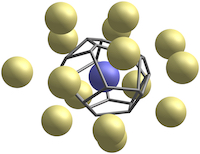Version 1.0
Version 1.0 was released in June of 2024, adding several new features. In particular, this version is designed to use the new multithreaded version of Voro++. In addition, two dimensional functionality was added.
VoroTop code and installation instructions can be obtained from the VoroTop git repository.
Please see the VoroTop Tutorial Through Examples for hands-on lessons for learning how to use VoroTop. Through carefully designed examples, you will learn to perform various types of Voronoi topology analysis, starting from basic calculations to more advanced techniques.
An implementation of VoroTop is available in OVITO.
Filters
Filters specify sets of Voronoi topologies associated with particular structure types. Each filter is stored in a text-based format. Structure types are listed first, and are labeled with increasing integer values starting at 1. Subsequent lines specify topological types (as recorded through Weinberg vectors) and their associated structure types.
Below are filters for several common structure types. Please be in touch if you are interested in generating additional ones not listed here.
| Filter name | Structure | Notes | |
|---|---|---|---|
| BCC | 1 | BCC | Identifies particles with body-centered cubic (BCC) local structure; ignores all other structure types. |
| FCC | 1 | FCC | Identifies particles with face-centered cubic (FCC) local structure; ignores all other structure types. |
| HCP | 1 | HCP | Identifies particles with hexagonal close-packed (HCP) local structure; ignores all other structure types. |
| ICOS | 1 | ICOS | Identifies particles with icosahedral local structure; ignores all other structure types. |
| FCC-HCP | 1 2 | FCC HCP (non-FCC) |
Designed for studying FCC systems with HCP-type defects (e.g., dislocation, twin planes, and stacking faults). |
| HCP-FCC | 1 2 | HCP FCC (non-HCP) |
Designed for studying HCP systems with FCC-type defects (e.g., dislocation, twin planes, and stacking faults). |
| FCC-both-HCP | 1 2 3 | FCC FCC/HCP HCP |
Designed to study systems with both FCC and HCP local structure. |
| Filter name | Structure | Notes | |
|---|---|---|---|
| Crystal | 1 | Hexagonal | Identifies particles with hexagonal crystal structure in two dimensions. |
Feedback
This software is currently under development. Please feel free to be in touch with questions, comments, requests, or other suggestions for improvement. Also, if you are interested in collaborating on interesting research projects, please be in touch.
Related Software
The following software packages can be used in conjunction with VoroTop:
| Voro++ | A software library for computing three-dimensional Voronoi tessellations, developed by Chris Rycroft (Harvard). | ||
| OVITO | A visualization and analysis software package for atomistic data, developed by Alexander Stukowski (TU Darmstadt, Germany). | ||
| AtomEye | An atomistic configuration viewer, developed by Ju Li (MIT). |
